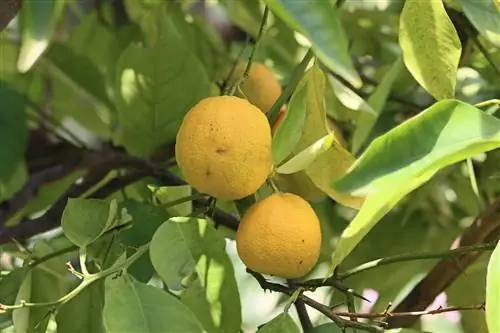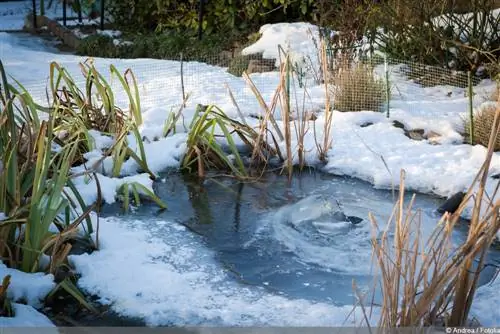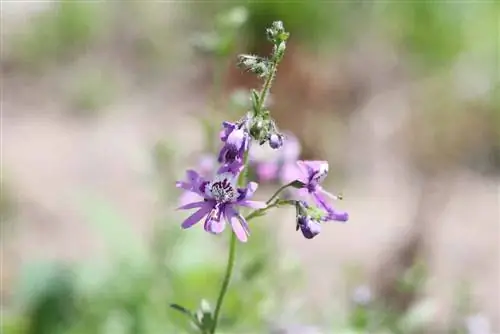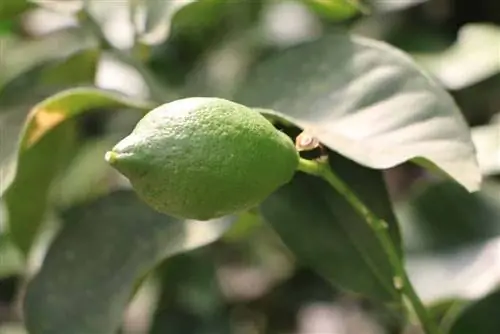- Author admin [email protected].
- Public 2023-12-17 03:39.
- Last modified 2025-01-24 12:45.
Citrus plants belong to the rue family, which comes from the region of southwest Asia. There is a tropical or subtropical climate there and therefore exactly the living conditions that these plants need.
Citrus fruits, such as lemons or oranges, are the fruits of citrus plants and are a special form of berries. Their preference for warm and humid climates ensures that citrus plants thrive especially in warm parts of the world. There they are cultivated either as a tree or as a shrub, which means they can reach heights of up to 25 meters.
- young branches in light green and with edges
- older branches dark green and round
- Leaves oval to oblong, dark green above, light green underneath
- white flowers, fragrant
- Fruits spherical, pear-shaped and of different sizes
The origin of citrus plants
Citrus plants originally come from the East Asian region, the precursors were also known in the Himalayas, in Myanmar and in China in the Yunnan Province. Already in a text from around 2205-2197 BC. Citrus fruits were mentioned in China in the 1st century BC, and the citron is said to come from India. It was also the first citrus fruit brought west by humans. The lemon tree was first planted in Persia and introduced to Asia Minor by the knights of Alexander the Great. The philosopher and natural scientist Theophrastus of Eresos gave a precise description of the citron in the eastern Mediterranean, which led the way to southern Europe, where it and its other relatives still grow and thrive today.
The Mediterranean ambience and southern flair, which automatically comes to mind when a plant lover hears the word citrus plant, is also the reason for its popularity. One immediately associates southern sun, bright blue sea and a cloudless blue sky with the country where the lemons bloom. Many a traveler has taken a citrus plant home with them from their vacation in Italy, Spain, Greece or one of the other countries on the Mediterranean. If not, you can now buy them from specialist retailers and even order them online. The question of whether and how you should cut and overwinter citrus plants is important and interesting.
General information about the location of the citrus plant
In nature, the citrus plant grows and thrives in warm regions, although the heat must be present for a sufficient period of time. Even the fruits require storage at temperatures around 7°C with appropriate humidity. If the temperatures get too cool and the humidity is too dry, the citrus plants may continually produce new small fruits. This is not natural and can actually harm the plant, even if the little mini lemons or oranges look cute.
Problems overwintering
In summer, citrus plants can stand on the terrace and enjoy the full sun. Here they delight the owner and everyone who looks at this beautiful plant. But as soon as the temperatures get cooler, it's time to move the citrus plant to a suitable place to overwinter. Although a conceivable solution would be to simply bring the plant into the house, firstly the significant difference in temperature and secondly the changed lighting conditions are problematic. Especially if it is a potted plant that needs winter rest, the winter quarters should be chosen particularly carefully. These places are ideal for this:
- Winter Garden
- bright staircase
- Greenhouse
- Basement
The winter garden actually only has advantages if the temperature can be adjusted and it is not used as a living space. Then it would be heated too warm and a bright stairwell would be a better location. The light and temperature conditions are usually right here; a disadvantage could be that drafts quickly arise. Even a greenhouse is not always the ideal place for a citrus plant in winter. Although the lighting conditions are excellent here, heating is required to avoid frost. The cellar is usually just right in terms of temperature, but too dark. In this case, artificial lighting with a timed plant light for 12 hours a day would be necessary.
Tip:
Before putting away, pour with lukewarm water from cold to warm.
Watering
During the winter period, citrus plants need little water. While the plant needs to be supplied with plenty of water every day in summer, it only needs a small portion at most twice a week during winter rest. More water would be harmful because the roots could rot. The death of the roots is initially manifested by leaf fall. For this reason, the potting soil should also be checked at a depth of approx. 1 cm to see whether it is as dry there as on the surface.
Fertilizer
When the citrus plant is being prepared for winter rest, it should, if possible, no longer be fertilized. This also applies to the hibernation period, because nutrients are simply not needed in this phase. The same goes for the citrus houseplant on the windowsill, which also doesn't get any fertilizer in the winter, even though it continues to grow.
Tip:
Always fertilize little and use special citrus fertilizer.
Light
The more light the plant gets during hibernation, the more active its photosynthesis is and the more water it needs. Then the principle of sparing watering no longer applies; the plant could dry out. In this case, a lot of light is just as harmful as bringing the plant in from the cold and leaving it cold and uninsulated on a cold ground with full lighting. In this case, because of the cold, the roots cannot absorb as much water as they need because of the strong lighting. So it's not just the temperatures that need to be adjusted, but also the amount of light.
Pruning citrus plants
Just like the tangerine tree, the citrus tree does not necessarily have to be cut back in order to have beautiful, strong leaf growth and flowers next year. Even with citrus plants, only one corrective cut is necessary to bring the tree into shape. If you want to do this, spring is the best time to do it, as the citrus plant can sprout again straight away. However, it may happen that no flowers are formed in the year of pruning and no fruit-bearing branches are cut off.
What you should know about citrus plants in brief
Due to their southern origins, the intensely fragrant citrus plants have a reputation for being particularly sensitive to care for. If you take into account some of the plant's essential basic needs, this is actually relatively uncomplicated. The most important requirements for optimal growth of your citrus plant are warmth, lots of sun and avoiding waterlogging and drafty locations:
- Most citrus plants prefer slightly acidic soil.
- The higher the temperatures, the more light there should be, otherwise the plants will develop soft, unstable shoots.
- You can determine the intensity of the light with a so-called lux meter.
- In extremely poor lighting conditions, there is still the option of using artificial lighting.
- Water your citrus plants in the morning or evening (not in full sun!): significantly more during the growing season (spring to early autumn) than during the dormant season.
- Low-lime, stale tap or rain water is sufficient. Always avoid waterlogging!
- Your citrus plant will show you a lack of water in good time by slightly curling the leaves.
- It is usually no problem for indoor citrus plants to overwinter in a heated (and bright!) room.
If you have potted plants, the winter quarters are a little more demanding: the cool cellar (+5 to +10°C) is ideal here, but there must be enough light and, if necessary, artificial light and a timer can be used. Place the plants inside before the first frost and leave them there until spring. Do not fertilize!
Another insider tip:
Coconut substrate, which is commercially available in pressed form and must swell in water before use, has recently proven to be particularly effective as a breeding ground for citrus plants. Coconut substrate prevents fungal development and fortunately offers an enormous human benefit as it serves as a new source of income for the third world.
The most well-known types of citrus include the conventional orange and lemon, but more unusual ones such as kumquat, grapefruit, chinotto (bitter orange) or calamondin (dwarf orange) and mandarin can also be cultivated with us, although they are more likely to be obtained from a special breeder need to buy.






